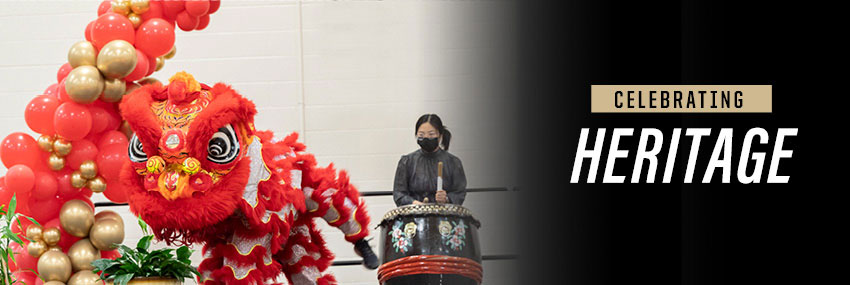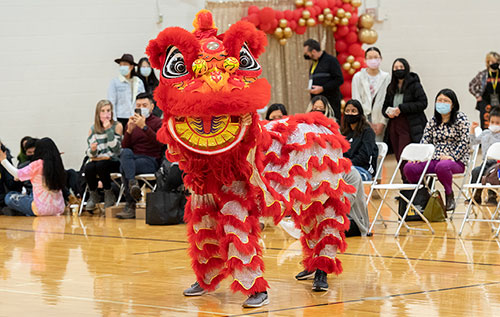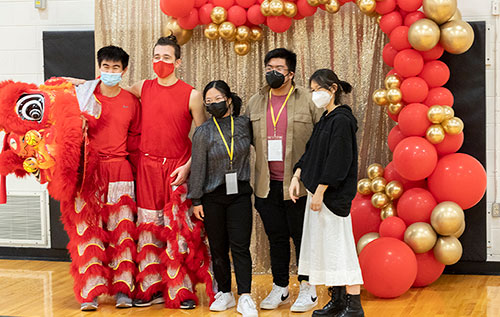
Drum beat of the Lion Dance brings Chinese heritage to Purdue
 The Asian American and Asian Resource and Cultural Center (AAARCC) Lion Dance group is showcasing Purdue’s cultural diversity and entertaining the community with the Lion Dance. This traditional Chinese performance features a brightly colored, fierce-looking lion that dances to the beat of drums and symbols. The dance is meant to scare away evil spirits and bring good luck.
The Asian American and Asian Resource and Cultural Center (AAARCC) Lion Dance group is showcasing Purdue’s cultural diversity and entertaining the community with the Lion Dance. This traditional Chinese performance features a brightly colored, fierce-looking lion that dances to the beat of drums and symbols. The dance is meant to scare away evil spirits and bring good luck.
Featured around the world, the Lion Dance originated in the 3 rd Century and is integral to the spring Lunar New Year celebrations, as well as other happy events. On campus, the team also has or will perform for the AAARCC Senior Send-Off, Boiler Gold Rush, Family Weekend, City of West Lafayette Global Fest and even a class in exploratory studies.
The lion costume is worn by two students, one who takes the enormous head and the other the tail end of the costume.
Josh Tseng, a first-year student from the Bay Area in California majoring in kinesiology, this year took the oversized bamboo-framed head on his shoulders, pantomiming a roar, wiggling its ears and blinking its enormous eyes. For the Purdue Lunar New Year celebration in February, the duo started on stage at the France A. Córdova Recreational Center but then leaped off and wove through the photo-snapping audience. This fall the dance was performed in the streets of West Lafayette and on stage behind the Asian American and Asian Resource and Cultural Center ( AAARCC) during the collaborative Express Fest event, an open house and resources fair for three of Purdue’s cultural centers.
 The lion’s movements were synced to the clash of cymbals and the music of drums beaten by Emily Reyes, a first-year student from the Los Angeles area. She is working toward a double major in mechanical engineering technology and industrial engineering technology.
The lion’s movements were synced to the clash of cymbals and the music of drums beaten by Emily Reyes, a first-year student from the Los Angeles area. She is working toward a double major in mechanical engineering technology and industrial engineering technology.
The team performs the southern style of this Chinese dance, which originated in Guangdong. In this version, the focus is on the fierce creature, while the lion in the northern version is more playful and the dance integrates more acrobatics. This performance is commonly confused with the traditional Dragon Dance, which is more of a giant, flexible puppet on long poles and manipulated by up to 15 people per dragon.
Both Reyes and Tseng said the hardest part is keeping the heavy lion head in sync with the drums.
“Technically I am his eyes,” Reyes said “He can’t see out of his head well. I change the beat so that he knows what to do.” The team practiced the movement and choreography with the help of trainer Kwan Hui, member of the Indiana Association of Chinese Americans, a community organization based in Indianapolis. Josh Tseng also contributed much to the choreography, and members also brainstormed together by watching YouTube performance videos of other Lion dance teams.
Tseng added, “During our last performance, I lost track of time and was going too long, so she changed the beat, and I knew what to do.”
Tseng, who has been performing the dance since 8 th grade, said he is challenged to bring the lion to life while often choreographing the dance “on the fly” for a wide variety of often unfamiliar venues.
The Lion Dance team of six to eight students also includes students who clang the cymbals, dance in costume, and wave flags. The AAARCC provided all the inaugural costumes and equipment. The elaborate costuming is the group’s biggest expense thus far. The current two lion costumes, both purchased used, were imported from Australia.
Torin Vandervort, a junior majoring in visual communication design from Peterborough County, N.H., performed last year when the team was just getting started but this year was focused on administration and grant writing. Thanks to Vandervort’s efforts and support from Purdue’s Student Organization Grant Allocation Board, new costumes are on their way for lions, one of which is equipped with LED lights, and a dragon for starting a future dragon dance team.
To the students, the dance is about more than entertaining.
“Regardless of ethnic or athletic background, this team is very accepting, and we work with everyone as a team to build each other up,’ Reyes said. “We can’t have a one-man lion dance. It is important to make sure everyone is welcome and has fun. That’s what we are all about.”
Vandervort agreed and added, “It’s just important to have groups like this on campus, especially given how diverse Purdue is.”
The Lion Dance Team, an AAARCC group, was founded in the fall of 2020 with the encouragement of Pamela Sari, the center’s director. Gwynelle Condino, now an alumna, was the inaugural captain. Also serving as the undergraduate student ambassador, Cordino trained the team, meeting with members virtually due to the pandemic. The team performed for the first time in a virtual Lunar New Year celebration in spring 2021.
“Our goal is to develop students' leadership skills, cultural competency, and creative performance skills,” Sari said. “As the Lion Dance continues to grow, the AAARCC is hoping this cultural initiative will attract many more students to join.”
The AAARCC is located at 915 Fifth St. It was founded in 2015 as part of the university’s effort to foster a diverse and inclusive campus. AAARCC is the newest of the Purdue’s cultural centers, which also include the Black Cultural Center, Latino Cultural Center, Native American Educational and Cultural Center, and LGBTQ Center.
Contact
915 5th Street (corner 5th/Waldron)
West Lafayette, IN 47907
Email: aaarcc@purdue.edu
Phone: 765-496-0488
Fax: 765-494-1225
Facebook | Twitter | Instagram
Center Hours
Summer 2023 Hours (begins May 26th)
Remote Work:
Monday & Friday
9:00 AM - 4:00 PM
In-person hours:
Tuesday-Thursday
9:00 AM - 4:00 PM
Fall & Spring Semester Hours
Monday - Friday
8:00 AM - 5:00 PM